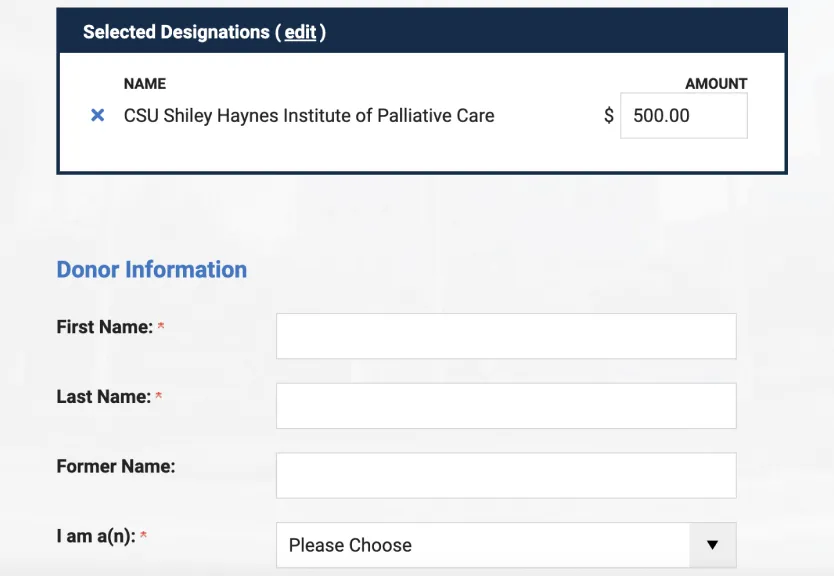Joan Fisher, MD, PhD, FAAP, to Address Pediatric Palliative Care
CSU Shiley Haynes Institute for Palliative Care is delighted to announce that Joan Fisher, MD, PhD, FAAP, will be speaking at the 2022 National Symposium for Academic Palliative Care Education and Research, April 21─22, in San Diego. She practices palliative care in Pediatric Hematology-Oncology, at Lucile Packard Children’s Hospital, Stanford, and is medical director at George Mark Children’s House, a pediatric palliative care Center for Excellence and inpatient facility in San Leandro, CA.
Dr. Fisher is an inspiring and nationally recognized clinician-educator who has dedicated her career to improving care for pediatric patients with serious illnesses and their families. She is board certified in both Hospice and Palliative Medicine and Pediatric Hematology-Oncology. At the Symposium, she will offer a plenary session, “Pearls for Providing Pediatric Palliative Care,” and a workshop, “Communication With Medically Complex Children and Their Families.” In a recent interview, Dr. Fisher shared some of the thoughts underpinning her presentations; the following summarizes and paraphrases the conversation.
Pearls for Providing Pediatric Palliative Care
What do you want the Symposium attendees to hear about pediatric palliative care?
Sometimes people are scared to care for children. Your job is to support families—and you already know how to do that. Taking care of families with children is really not so different from taking care of families with an older adult. You are helping them through it.
Telehealth is a big help with connecting with children because they are more familiar with the digital world and are more remotely connected. Parents aren’t phased by telehealth as providers can do it without a mask, and [the families] are grateful you are there with them.
Often, families of pediatric patients have questions and just need some answers. Telehealth allows you to talk normally to families about what they are about to go through. Video calls are so much better than just voice. (The CSU Shiley Haynes Institute for Palliative Care offers a short self-paced course with tips and guidance from clinical experts in conducting patient visits through technology: Telemedicine Skills for Clinicians.)
How has COVID changed practice and what has changed for families?
The expansion of telehealth has been both a boon and a heartache. During COVID, telehealth has come into its own and is now more present at the table. It’s been helpful to be able to see patients and families in their own environments. But it’s been heartbreaking to only have one parent present [when a child is hospitalized]. COVID made it more difficult to have family members present, and even with telehealth, it’s more difficult to engage other family members in the care. It’s really a tragedy not to have family members present.
Thoughts on the Theme: Disparities, Distress, and Directions for the Future
What do you see emerging from the pandemic?
The emerging technology has broadened our ability to reach out to people in ways that weren’t there before. Children who have never had computer access before have access now. The [Stanford] health system responded overnight to bring access via telehealth into use. To see patients and seeing how they are doing brings peace of mind to the family and to the healthcare provider. Larger meetings such as the Tumor Board are now on Zoom, which is positive. It is better as you can hear questions and time of travel is not lost.
The negative side of technology is [that] it is an interruption, and we lose uninterrupted time. The most important thing we bring to families is our minds and hearts and the attention and presence of that is valuable. Technology robs us of quiet thinking with a patient.
Now, too, the children are sicker when they come in because they have waited because of COVID. They end up in the ER and then they get seen. It’s hard to see them, to have cared for them for so long through so much, and then to see them get COVID and die. This has been heart wrenching for everyone.
Workshop on Palliative Care Communication Skills with Children and Families
What’s one “tip” out of what you will share for communication with children and their families?
Be happy when you walk in the room with the children. Find some humor. Children can’t be sad or down all the time, and neither should you.
Systemwide Palliative Care
What about palliative care? How will it be affected by this time?
A survey of Stanford Hospital [staff, clinicians, and patients] found that everyone noted that they needed more palliative care services and more developmental services. Even at Stanford, our pediatric palliative team has several people who are funded at less than 1FTE. We’ve recommended an “honest to god” palliative care service to provide care throughout the hospital, to teach people how to do palliative care, so they can expand support for children and families. We’re not there yet.
The other huge impact of our times: More burnout and massive medical and nursing turnover. We must support resilience in [clinicians]. Stanford has had a longstanding departmental focus on self-care, resilience, and wellness. It really has to come from the top.
For more from Dr. Fisher, attend the National Symposium on Academic Palliative Care Education and Research, April 21–22, in San Diego.




